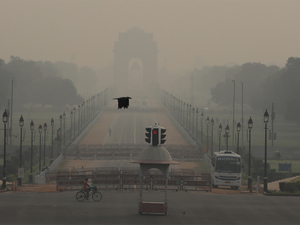 Reuters
ReutersThe overall air quality in the national capital slightly improved but remained in the poor category on Monday morning, with the Air Quality Index (AQI) clocking at 235, said Centre-run System of Air Quality and Weather Forecasting And Research (SAFAR).
The concentrations of the particulate matter (PM) with a diameter of 10 and 2.5 microns stood at 249 in the moderate category and 101 in the poor category.
SAFAR has predicted a marginal improvement in Delhi's overall air quality. "AQI is likely to marginally improve to the moderate category for tomorrow. Moderate to poor AQI is forecast for March 23 and 24. Isolated thunderstorms with gusty winds can lead to local dust lifting on March 23 and 24," SAFAR said in its bulletin.
As per government agencies, an AQI within the range of 0-5 is regarded as 'good', 51-100 is 'satisfactory', 101-200 is 'moderate', 201-300 is 'poor' and 301-400 is 'very poor' and 401-500 is considered 'severe'.
Meanwhile, the Regional Weather Forecasting Centre (RWFC), has predicted light to moderate rain over the isolated places of Rajasthan's Bhadra, Sidmukh, Sadulpur and Haryana's Hansi, Hissar, Tosham, Barwala, Narwana, Siwani, Adampur, Fatehabad during the next 2 hours.
The concentrations of the particulate matter (PM) with a diameter of 10 and 2.5 microns stood at 249 in the moderate category and 101 in the poor category.
SAFAR has predicted a marginal improvement in Delhi's overall air quality. "AQI is likely to marginally improve to the moderate category for tomorrow. Moderate to poor AQI is forecast for March 23 and 24. Isolated thunderstorms with gusty winds can lead to local dust lifting on March 23 and 24," SAFAR said in its bulletin.
As per government agencies, an AQI within the range of 0-5 is regarded as 'good', 51-100 is 'satisfactory', 101-200 is 'moderate', 201-300 is 'poor' and 301-400 is 'very poor' and 401-500 is considered 'severe'.
Meanwhile, the Regional Weather Forecasting Centre (RWFC), has predicted light to moderate rain over the isolated places of Rajasthan's Bhadra, Sidmukh, Sadulpur and Haryana's Hansi, Hissar, Tosham, Barwala, Narwana, Siwani, Adampur, Fatehabad during the next 2 hours.
Read More News on
Download The Economic Times News App to get Daily Market Updates & Live Business News.
2 Comments on this Story
 | Jayeshkumar Panchal43 minutes ago Delhi's Air Quality is Poor because India is more worried about the US loosing the Energy Jobs, than doing what is needed to Reduce Air Pollution in Delhi. . . . India has one of the Best Technology in the world (shown at AutoExpo2000, New Delhi, 20 years ago!) for drastically reducing the Energy, Fuel and Emission from our Automobiles, ..by getting Rid of their Energy Wasting Friction Brakes. |
 | Jayeshkumar Panchal53 minutes ago In my opinion when Dust particles meet HC (Fuel) vapor, it remains suspended in the Air for longer time, with Lighter Hydrocarbon Molecule not letting the Heavy Dust come down and settle on the ground. As for Reducing the Fuel Vapor, India has one of the Best Technology in the world to drastically reduce the use of Fuel in Automobiles, by getting Rid of their Friction Brakes (A Unique Transmission Technology was shown at AutoExpo2000, New Delhi. ..20 years ago!). |